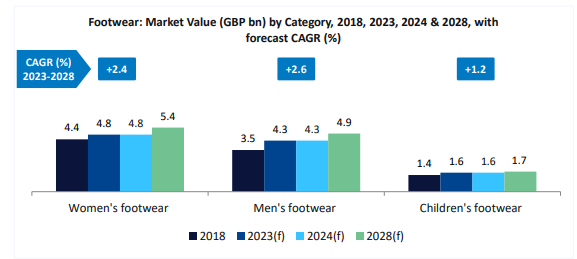
The Apparel market in the UK to 2028 report published by GlobalData revealed trainers are projected to maintain their status as the “preferred footwear choice” with a CAGR of 2.4% over the next few years as consumers prioritise comfort and versatility. Footwear brand Vivobarefoot is tapping into this trend by providing circular-based footwear options.
Men’s footwear overall is predicted to be a standout performer, however womenswear is also expected to do well with a CAGR of 2.4%. Childrenswear is expected to have slower growth at just 1.2% due to declining birth rates.

Shoes and boots will grow at a slightly slower pace with a CAGR of 2.2%, driven by renewed demand for formal and office footwear. Slippers and footwear, however, are projected to rise at a modest CAGR of 0.6%, reflecting reduced demand for home comfort footwear post-pandemic.
Circularity is a dominant theme in the apparel and footwear sector
GlobalData’s analysis of company filings data reveals circularity emerged as a predominant theme in the apparel and footwear sector from May 2022 to May 2024, although mentions dipped to 98 in 2024. Climate and governance were also significant themes with 82 and 74 mentions, respectively.

UK shoe manufacturer Vivobarefoot has introduced what is reportedly the first scan-to-print circular barefoot footwear called Vivobiome.
The concept allows consumers to scan their feet with their phone and select a preferred fit using the Vivobiome fit visualiser. The platform is supported by over 100,000-foot scans that have computationally driven 38 data-driven size options for customers to match their feet by width and length to the preferred fit.

US Tariffs are shifting - will you react or anticipate?
Don’t let policy changes catch you off guard. Stay proactive with real-time data and expert analysis.
By GlobalDataVivobareoot’s manufacturing process uses Selective Laser Sintering, a powder-based 3D printing technology, to create a durable, high-performance barefoot outsole.
“This additive manufacturing process enables you to make only what you need when you need it, which also helps to reduce waste significantly,” added Vivobarefoot.
Vivobarefoot emphasised the benefits of the circular knitting process, which seamlessly constructs a 3D foot shape in a single upper, thereby minimising waste and enhancing barefoot feel and performance.
Vivobarefoot views the integration of 3D printing with advanced bio-based materials as a way to combat the footwear waste challenge. It facilitates on-demand production, extends tge product lifespan through personalisation, and ensures a clear circular end-of-life for used products.
The company explained that Vivobiome will soon be made-to-order, made-to-measure, made locally and made-to-be remade.
The first Vivobiome shoe is the Hybrid Wing which retails at £260 ($327.19) and comes in two colourways – Obsidian/Origin Red and Obsidian Origin Blue. These designs are limited editions with only 1,000 pairs available in each colourway.
The Apparel Impact Institute has set an ambitious target of reducing 100m tonnes of CO2 emissions from apparel and footwear supply chains by 2030 and has identified six ways to get there.



